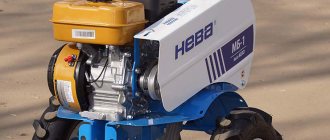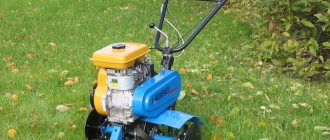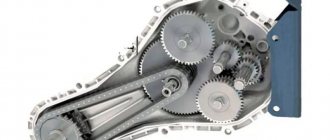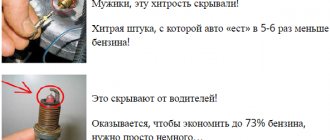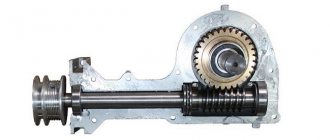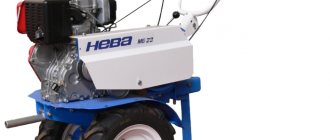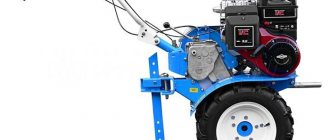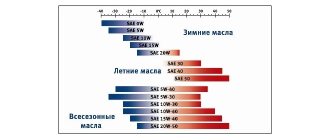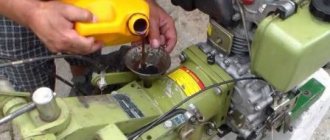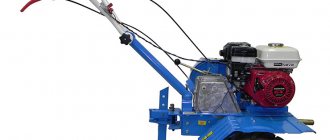We choose the best oil for a walk-behind tractor and learn how to change it correctly: in the gearbox, engine
During operation of the walk-behind tractor, the engine is subjected to heavy load and, to protect it from premature wear, motor oil is used. The product varies in chemical composition and properties, so it is used according to classification.
Changing the oil in the gearbox
To lubricate the gearbox, use any transmission oil, for example, TAD-17, TAP-15V or with other markings in accordance with GOST 23652-79. Before filling it, check for the presence of old fluid. If necessary, it must be changed after first checking the volume of the tank. Checking in walk-behind tractor models such as Neva is carried out as follows:
- The equipment is placed on a horizontal surface so that there is access to the gearbox, and the equipment itself is in an inclined position (this will make it more convenient to pour the product).
- Insert a probe into the hole on the gearbox (this can be a metal rod 65-70 cm long, bent into an arc) and use it to measure the level of presence of the substance.
If the dipstick immersed in the gearbox is 30 cm deep in the liquid, then there is no need to fill it additionally. If the results are different, the lubricant should be poured into the gearbox to the required level. You will need to pour at least 2 liters of lubricant into a completely dry gearbox.
Possible problems and their solutions
In the process of changing the oil in the gearbox, as a rule, no problems arise, but there are problems in the operation of the gearbox itself, because Any actively used equipment breaks down. You can fix most problems yourself:
- The clamps or spring are broken. You should purchase new ones, then configure them.
- The shift settings are lost - loosen the screws, select first gear, then tighten the screws again.
- Oil is oozing through the shaft - the cuff may be worn out. It should be replaced with a new one. How to change seals? Pull out the old ones, carefully pry them off with a screwdriver, then put the others there.
- If it jams, the chain may have broken. Need to buy a new one.
- The gear does not lock - the fork brush is outdated and needs to be replaced.
It is useful to regularly inspect the parts of the mechanism in order to notice breakdowns in time. Buy only good spare parts, then they will last a long time and without “surprises”. The quality of the lubricant also matters.
A specialist can provide high-quality service to the engine and its individual parts.
Neva MB two is unpretentious, but requires attention. The model is popular due to its low cost and excellent build quality when compared with a number of competitors. The gearbox is considered an important part of the mechanism. If your own knowledge is not enough to eliminate breakdowns, it is better to involve a specialist.
Like other equipment, Neva requires special care and regular replacement of lubricant. Otherwise, the gearbox will overheat and the parts will quickly wear out.
Some owners, confident in the quality of foreign products, purchase American oil and fill it calmly. However, the main source of data should be the instructions supplied with the unit. There, the manufacturer describes in detail the procedure for filling the lubricant, the frequency of replacement, and most importantly, the recommended type, transmission or some other.
For homemade equipment, you should follow the instructions from the device that is closest in design to it. After all, the master manufacturer took the existing type of gearbox as a basis, and only then made his own changes.
The video below shows in detail how to correctly change the oil in the gearbox of the Neva MB2 walk-behind tractor.
What kind of oil to pour into a walk-behind tractor
As a rule, in the instructions for motorcycle equipment, the manufacturer indicates which brand of engine oil and in what volume is best to use. If there are no such recommendations, the product is selected according to the following characteristics:
- SAE;
- API;
- ACEA.
The SAE parameter indicates the viscosity class of the substance and consists of an alphanumeric abbreviation, where the letter “W” indicates the possibility of use at low temperatures. The number in front of it indicates the viscosity at negative thermometer values, and the numbers after the “dash” indicate at positive values. These indicators characterize how easily the liquid will be pumped through the system, and how quickly it will reach the surfaces of the rubbing parts, preventing them from dry friction.
The API parameter divides the lubricant according to its performance properties into categories C and S. Category C includes products intended for four-stroke air-cooled diesel engines, and category S for gasoline engines. Therefore, when choosing a fluid, you should definitely pay attention to this marking, since it has a different composition for diesel and carburetor engines.
The ACEA rating classifies an oil based on its HT (High Temperature Viscosity)/HS (Shear Rate) rating, which indicates how energy efficient the lubricant is. The higher this value, the better it protects engine components from wear. It is recommended to pour a substance with a high mPas indicator into a tractor, mini-tractor, as well as heavy Neva walk-behind tractors designed for heavy loads.
Below are the types of machine lubricants that, according to their characteristics, are the most optimal for a cultivator or walk-behind tractor. Of course, they can be used if there are no special recommendations from the equipment manufacturer, and in accordance with the S and C markings. So, these are the oils:
- 5w30, 5w40 - all-season, which can be poured into motorcycles at an ambient temperature of at least 25 o C;
- 10w30, 10w40 - having anti-corrosion properties;
- 15w40, 20w40 - intended for pouring into the engine at a temperature of 45 o C and above;
- 0w30, 0w40 - created for winter use;
- MIL-L - designed for military vehicles and can be used on walk-behind tractors with diesel (code 2104) and carburetor (code 46152) engines.
Maintenance of the NEVA MB-2 walk-behind tractor // Changing the engine oil // Part 1
Dual-labeled lubricant (SG/CD, SF/CC) can be poured into any engine: it is universal and equally suitable for both diesel and gasoline-powered engines (such as the Texas motor-cultivator). Among the variety of lubricant products, the most popular are products produced under the brands Mobil, Castrol, ZIC, Shell Helix. To improve the action and improve the quality, additives are added to it - Oil Additiv, BIZOL, Cera Tec and others. They can be used at ambient temperatures from 25 °C to 25 °C.
Purpose
When purchasing a new walk-behind tractor, the kit must include accompanying documents, which contain special sections with recommendations for proper care and operation. The names of oils ideally suited to the unit are also indicated there.
First of all, you should understand the basic functions of oil fluids. Liquids perform the following actions:
- system cooling;
- obtaining a lubrication effect;
- cleaning the inside of the engine;
- compaction
During operation of the walk-behind tractor in an air-cooled engine, the oil liquid begins to burn, and accordingly, burnt particles remain on the cylinder. This is why smoky exhaust is formed. In addition, tar deposits are the strongest pollutant for the remaining parts of the walk-behind tractor, making lubrication of parts more difficult.
It is preferable to fill the oil for a walk-behind tractor together with antioxidant liquids, which are a cleaning agent for the inside of the unit.
To choose the right oil fluid, you should remember that each individual composition is intended for a specific season and climatic temperature.
In simple words, you cannot use summer oil at temperatures below 5 degrees - this can lead to failure to start the engine.
- The summer variety of oil liquid is used exclusively in the warm season. Has a high level of viscosity. There is no letter designation.
- Winter varieties of oils are used during cold periods. They have a low viscosity level. The letter designation is W, which means “winter” in English. This variety includes oils with the SAE 0W, 5W, 10W, 15W, 20W, 25W index.
- A variety of all-season oils are becoming more popular in the modern world. Their versatility allows you to fill the engine with liquid at any time of the year. It is these lubricants that have a special index in the general classification: 5W-30, 10W-40.
In addition to seasonality, oils are divided by composition. They are:
- mineral;
- synthetic;
- semi-synthetic.
In addition, all oils differ in the performance requirements of a 2-stroke and 4-stroke engine.
Walk-behind tractors usually use a 4-stroke air-cooled system, so the oil must be 4-stroke. In the winter season, the most preferable option is transmission engine oil, for example, 0W40.
The price of the issue is, of course, high, but the response of the unit is its long service life.
How to change the oil
In order for motorcycle equipment to function smoothly and serve for a long time, it is necessary to periodically replace the lubricant in the gearbox and engine. The first time this is done after break-in, and then after every 50-100 hours of operation of the motorcycle (under intense loads, “filling” will be required even more often), unless otherwise indicated by the manufacturer.
Changing the engine oil
The procedure for replacing lubricant in the engine is as follows:
- The motor vehicle engine is started and warmed up.
- The walk-behind tractor is installed on an elevated horizontal surface.
- Open the tank drain hole to drain the contents into a separate container, and then close it tightly.
- Pour a new product through the filling hole, monitoring its level with a dipstick.
- Use a dry cloth to wipe the drain and fill holes, carefully removing any remaining lubricant.
Motor oil is not cheap, but you shouldn’t skimp on it, just like on fuel. You only need to fill in lubricant that is original and of high quality, since the performance of the walk-behind tractor, as well as the durability of its mechanisms, will depend on it. Only a high-quality product with correctly selected parameters can provide the most beneficial effect and ensure minimal wear on the internal parts of the engine. The instructions are suitable for such walk-behind tractors as S htenli (Shtenli), Patriot, Tarpan, Cascade, Khoper, Agat, Oka, Luch, MTZ.
Changing the oil in a walk-behind tractor engine
The working life of the engine of an agricultural unit depends not only on the quality of its components and assembly, but also on how correctly and how often you change the engine oil. By adhering to the manufacturer’s recommendations, you can extend the life of the unit and protect it from typical breakdowns.
To change the lubricant in a walk-behind tractor, you must first warm up the unit’s motor. To change the oil in a walk-behind tractor engine, you need to proceed in the following order:
- First install the unit in a horizontal position. The holes for filling and draining oil are always located on the left side of the walk-behind tractor engine. The remaining oil inside the engine must be drained through the drain hole, which is closed with a conical threaded plug. If the plug is twisted too tightly, you can unscrew it using a long screwdriver;
- Place a wide container with a volume of at least 2 liters under the drain hole and slowly unscrew the plug. Having finally removed it, wait 10 minutes until the lubricant is completely drained from the walk-behind tractor engine;
- After this, tighten the drain plug and start filling in new engine oil. It is best if you choose 10W40 synthetic or mineral based oil as your new formulation. Its volume should be equal to the amount of previously drained oil.
READ How to start a gasoline walk-behind tractor in cold weather
The lubricant in the walk-behind tractor engine should be changed at least once every 25–30 hours of operation. If you do not use the unit too often, and all work takes you about the same amount of time, then you can change the oil once a year. At the same time, remember that if you do not have time to work 30 hours per season, then the oil still needs to be changed, since during the time the walk-behind tractor is idle, the properties of the composition deteriorate noticeably.
If you have just purchased a walk-behind tractor, then you need to change the lubricant in its motor within the first 5 hours of operation of the unit. The fact is that after assembling new walk-behind tractors, small debris remaining inside the engine gets into the oil, which leads to engine jamming and minor breakdowns. In order for the engine of the new unit to be completely cleaned, the oil in it will need to be changed three more times - 2 times after 5 hours of operation, and the third time after 10 hours.
How to replace the lubricant in the gearbox?
The procedure is as follows.
- Before you start filling in new fluid, you need to drain the old one.
- Place the cultivator on a raised platform. This will make it easier for you to drain the lubricant.
- You will find 2 plugs on the gearbox. One of the plugs is intended for drainage; it is located at the bottom of the unit. The other closes the filler neck. The filler plug is removed first.
- Take any reservoir and place it directly under the oil drain plug.
- Carefully unscrew the oil drain plug. The transmission oil will begin to flow into the container. Wait until absolutely all the oil has drained, after which you can screw the plug into place. Tighten it to the limit using a spanner.
- Insert a funnel into the filler neck. Use the appropriate lubricant.
- Fill it to the required level. Then replace the plug. Now you need to find out the lubricant level. Tighten the plug with the dipstick until it ends. Then unscrew it again and inspect it.
- If there is lubricant at the tip of the probe, no more should be added.
Oil in the gearbox of a walk-behind tractor - how to check and change?
The gearbox is an important element of the walk-behind tractor, the function of which is to transmit torque from the motor to the wheels of the unit via a V-belt drive. Gearbox parts are subject to increased wear and therefore require regular lubrication. Let us immediately make a reservation that not all products available on the market are suitable for this purpose.
The best option for lubricating the gearbox is gear oil. This type of compound is excellent for lubricating moving parts. The second important question is how much lubricant should be poured into the gearbox. To find out, you will need to perform a number of specific actions:
- Carefully place the walk-behind tractor so that its wings are parallel to the surface;
- Take a wire at least 70 cm long and bend one of its sides into an arc;
- Insert the wire through the filler hole until it stops, then pull it back out.
Next, look at the wire. If its wet side is 30 cm, then there is no need to add oil to the gearbox. If the lubricant level is lower, then you will need to add as much oil as required to reach the 30 cm mark on the wire. Lubricant must be poured into the gearbox in the following order:
- Place the walk-behind tractor on stands;
- Under the walk-behind tractor at the bottom of the gearbox, find the drain plug. Place a wide container under it and slowly unscrew the lid;
- Wait 10 minutes, during which all the oil will drain from the gearbox;
- Screw the drain cap all the way, unscrew the filler plug and place a funnel in it;
- Fill the gearbox with approximately 2 liters of transmission oil;
- Check the level of the composition using a wire - if there is less than 30 cm of wire in the oil, then add a little more material.
In most cases, it is necessary to change the lubricant in the gearbox of a walk-behind tractor at least once every 100 hours of operation of the unit. In this case, the frequency of replacement may vary depending on the recommendations of the walk-behind tractor manufacturer. If you use your agricultural machine for more than 4 hours a day, then you need to replace the composition once every 50 hours of operation of the walk-behind tractor.
How to check the level?
Checking the oil level is carried out using standard technology to which every person is accustomed. To do this, the walk-behind tractor has a special probe that goes deep into the unit. Having taken it out of the hole, at the tip of the dipstick you can see a limiting strip, the level of which is equal to the oil level. If there is not enough liquid, it must be added. On the other hand, this nuance forces you to check the entire system, since a low level of lubricant indicates that it is leaking somewhere.
In addition to the standard dipstick, some models of walk-behind tractors contain special sensors that automatically show the amount of lubricant present. Even during the process of replacing the oil fluid, it can be used to determine how much the size of the lubricant composition has increased or its deficiency.
In the engine
The primary oil change in the internal combustion engine occurs after 28-32 hours of operation. The next replacement can be made no more than 2 times a year - in summer and winter, even if the unit has been standing for some time without operation. To begin the replacement process itself, you need to prepare special attributes - a funnel and a container for draining the waste liquid.
At the bottom of the engine there is a hole with a cap through which old oil can be drained. A drain container is placed in the same place, the locking cap is unscrewed, and the waste liquid is drained. It is necessary to wait some time for the residue to completely drain from the engine system. The plug is then screwed into place and fresh oil can be added.
Its quantity should be identical to the drained amount. If it is not possible to take measurements, it is better to look at the technical data sheet of the unit, where the required number in grams is indicated. After new oil has been poured into the engine, it is necessary to check its level. To do this, just use a special probe.
It is worth noting that in some engines that are sensitive to oil fluids, for example, Subaru or Honda, it is assumed that they use oils of a certain class, that is, SE and higher, but not lower than the SG class.
This instruction is general for both two-stroke and four-stroke models. More specific information on how to replace the oil fluid in a walk-behind tractor is best considered in the instructions for a specific unit.
Is it necessary to add oil to gasoline for a walk-behind tractor?
To find out whether it is necessary to dilute gasoline for a walk-behind tractor, you need to study the instructions for its use. It indicates what type of engine the unit is equipped with - 2-stroke or 4-stroke.
If the walk-behind tractor is equipped with a 2-stroke engine, then the fuel mixture for it must necessarily consist of gasoline and oil. When preparing the mixture, follow the exact proportions specified by the manufacturer in the instruction manual. At the same time, fuel for a walk-behind tractor with a 4-stroke engine does not need to be mixed with oil, since all 4 strokes of such engines run on pure fuel.
It should be remembered that walk-behind tractors into which diesel is poured also do not require preparation of the fuel mixture. The fact is that all diesel engines are 4-stroke engines and run on clean fuel.
Which one is better to choose?
As mentioned earlier, there are several types of oils for walk-behind tractors. It is necessary to use the liquid recommended by the manufacturer of the unit - to do this, just carefully study the labeling of the device and read the instructions.
READ How to Set the Ignition on a Ural Motoblock
In addition, each individual type of oil is divided according to its chemical composition into several types. In most cases, manufacturers try to manufacture units with the ability to use the most common types of oils - synthetic, mineral, and semi-synthetics, for example, Mannol Molibden Benzin 10W40 or SAE 10W-30.
It is worth noting that this lubricant contains a friction modifier, which creates a durable film on the inner surface of the parts. This significantly reduces the wear rate of the walk-behind tractor.
Another marking that should not be forgotten is the designation of the operating properties of oils. It also has several varieties. For example, category C is used for 4-stroke diesel engines, and category S is used for gasoline engines.
From these data a certain conclusion can be drawn. Considering the engine types, a high level of demand is directed towards all-season oils labeled 5W30 and 5W40. Among anti-corrosion oils, 10W30 and 10W40 are popular.
At temperatures above 45 degrees, oils marked 15W40, 20W40 should be used. For winter cold, it is necessary to use oil fluid 0W30, 0W40.
Oil for a diesel walk-behind tractor - features of choice
When choosing engine oil for a diesel walk-behind tractor, you should follow the instructions in the operating instructions. However, if the instructions for use have been lost, then you will have to study the compositions available on the market more carefully.
Motor oils for diesel engines are classified into the following categories. The special markings indicated on the container with lubricant will help determine the type and compliance of the composition for a particular walk-behind tractor:
- API CJ-4 - compounds with this marking are designed specifically for walk-behind tractors with a capacity of 10 hp or more. With. and more. The composition of these lubricants has increased viscosity, which guarantees the proper operation of all elements of the unit’s motor;
- API CI-4 - these oils should be used for engines equipped with different types of injection and supercharging. Such oils have good dispersing characteristics and high resistance to thermal oxidation;
- API CH-4 - lubricants with this marking fully comply with all modern requirements and quality standards. Among the advantages of these compositions, one should highlight the ability to fill them into diesel engines running on fuel in which the sulfur percentage exceeds 0.5%;
- API CA - compositions of this type are optimally suited in cases where diesel fuel contains a small amount of sulfur. Oils with this marking protect the walk-behind tractor engine from the formation of harmful deposits on its walls;
- API CB - the use of oils of this oil reduces the risk of corrosion of walk-behind tractor bearings;
- API CC - such oils will be the best option for an engine equipped with a turbocharger, but without a supercharger. These compounds help walk-behind tractors withstand long-term loads and work properly in difficult conditions;
- API CF-2 - oils of this group perform well when used in walk-behind tractors that are subject to heavy loads.
After purchasing suitable motor oil, you can proceed to pouring it into the walk-behind tractor engine. The procedure for this is quite simple:
- First install the unit in a horizontal position;
- Place a wide container under the drain hole in the engine and remove the plug by carefully prying it off with a screwdriver;
- Wait until the old oil drains from the engine and screw the plug back into the hole;
- Pour at least 2 liters of new lubricant inside the engine.
Remember that the oil in new walk-behind tractors should be changed three times at intervals of 5 hours of moderate use. After this, replacement is required no more than once every 25 hours of operation of the walk-behind tractor.
READ Conversion of 16 wheels on an agro walk-behind tractor
Classification of oil grades
To increase the service life of a gasoline or diesel engine, you need to make the right choice of engine oil. Failure to replace it in a timely manner reduces the service life of the engine. How to choose it, in what quantity, how to pour it into the walk-behind tractor - we’ll talk about this in more detail.
READ How to Assemble Milling Cutters for Motoblock Bright 105
Each mini-tractor or walk-behind tractor includes instructions and a product data sheet. In the instructions, the manufacturer lists suitable types of fuel and lubricants that can extend the life of the equipment. Engine oil performs the following functions:
During air cooling, the lubricant settles on the walls of the hot cylinder. These deposits contaminate engine parts and complicate lubrication processes. Therefore, the lubricant contains antioxidant additives. They clean the cylinder walls from carbon deposits and extend the service life of the walk-behind tractor. Different climate zones require the use of different oily liquids. They differ in viscosity, composition and purpose.
For diesel engines
With the recommended motor oil, owners increase the resource of the unit and reduce diesel fuel consumption for a diesel walk-behind tractor. The instructions for a walk-behind tractor with a diesel engine indicate the following categories of lubricants:
- SA - for working with low loads;
- SV - for working with high-sulfur fuel;
- CC - for a non-turbocharged engine operating under increased loads.
Category CA reduces the amount of carbon deposits in the cylinders, but reduces the quality of the lubricant. Any lubricant is poured in the required volume. Reducing or increasing it leads to jamming of the motor.
Is it possible to fill a walk-behind tractor with motor oil?
This question is very relevant, especially among beginning farmers. Many of them use automobile motor oil, believing that there is absolutely no difference between it and the composition for pouring into a walk-behind tractor engine.
In fact, using car oil is a big mistake. The fact is that such a product does not have the characteristics that are necessary for the proper operation of the walk-behind tractor. The result of this is accelerated wear of the cylinders and piston group of the engine, which leads to breakdown of the walk-behind tractor and the need to completely replace its engine.
To prevent this, you should use specialized motor oil for a walk-behind tractor, the composition of which fully meets the requirements of an agricultural machine. To fill the engine, you can use 2-stroke or 4-stroke oil - it all depends on the type of engine of the walk-behind tractor.
The manufacturer of the lubricant is also of great importance - formulations from popular brands have proven themselves best in practice: Shell, Mobile, Castrol and Liqui Moly - they work equally well in engines manufactured by BriggsStratton, Subaru and other well-known companies. The third important factor is the seasonality of the motor oil - this characteristic determines at what temperatures the composition begins to lose its most important properties. In order not to make a mistake, we advise you to choose an oil for an all-season walk-behind tractor - it does not lose its characteristics at temperatures in the range from 25 to 40 °C.
Transmission oil for walk-behind tractor
When choosing gear oil, the first thing you should pay attention to is the recommendations of the walk-behind tractor manufacturer. Each of the brands involved in the manufacture of agricultural machinery uses mechanisms that are different in design. Accordingly, the latter require oils of different composition. To avoid mistakes when choosing gear oil, we advise you to study the table, which contains recommendations from the most well-known manufacturers of walk-behind tractors.
| Walk-behind tractor manufacturer | Transmission oil |
| Neva MB-1 | Oils of the TAP-158, TAD-17I brand and other compositions that comply with GOST 23652-79 |
| Neva MB-2 | Oils TM-5, TEP-15, as well as compositions corresponding to the classification SAE90 GI-2 and SAE90 GI-5 |
| Bison | The optimal use of transmission oil TAP 15 |
| Centaur | Transmission oils TAD-17I, TEP-15, TAp-15V, TSl-14 |
| Honda | 80W90 oil has proven itself best |
| Cascade | Transmission oils that comply with GOST 23552-79, or aviation oils MS-20 |
In addition to correctly selected transmission oil, the frequency of its replacement also plays an important role in extending the life of the walk-behind tractor. Here, as in the case of choosing a composition, you should pay attention to the advice of the walk-behind tractor manufacturer. In the table below you can study the oil change intervals for the most popular brands of walk-behind tractors.
| Walk-behind tractor brand | Manufacturer's recommendations |
| Neva MB-1 and MB-2 | The transmission oil must be changed at least once every 100 hours of operation of the walk-behind tractor. |
| Bison | The first oil change is carried out after 50 hours of operation of the walk-behind tractor in moderate mode. All subsequent replacements are made every 200 hours of operation of the unit. |
| Centaur | Transmission oil must be changed after every 75 hours of operation of the walk-behind tractor. |
| Honda | The oil should be changed after every 100 hours of operation of the walk-behind tractor. |
| Cascade | It is best to change the transmission oil every 150 hours of operation of the walk-behind tractor. |
The difference in the frequency of changing transmission oil for walk-behind tractors of different brands is due not only to the design features of the units, but also to their condition. After all, if a walk-behind tractor has a slight breakdown, then the transmission oil in it will lose its characteristics much faster than in the case of a fully functional unit. Be sure to take this into account and repair any existing breakdowns immediately after they are discovered.
By viscosity
Viscosity is determined according to SAE J300 standard. For mechanisms it depends on the following characteristics:
- unit design;
- features of work;
- age of the mechanism;
- ambient air temperature.
Motor oils are divided into winter and summer. Winter ones are designated with the letter W. Low-viscosity winter grades are often used with SAE designations 0W, 25W, as well as intermediate values 20W, 5W, 15W and 10W. Compositions for use in summer do not have letters in their names. They are distinguished by high viscosity and are designated SAE 20, 60, SAE 30 or 40. When using summer brands in winter, problems arise associated with starting the unit. Winter varieties are not capable of providing high-quality lubrication in the summer.
Scientists have developed all-season compositions that are used for pouring into walk-behind tractors in summer and winter. Their designations are 5W-40, 10W30.
Reviews of the Neva Motoblock with a 7.5 liter Subaru engine. With.
- The Subaru engine is simply something out of the ordinary. It works quietly, does not roar at peak, and uses oil and gasoline sparingly. I didn’t change the spark plugs or the filter, just cleaned it – it’s been two years now and works like new after running in. Previously, there was a walk-behind tractor with a domestic engine, but it cannot be compared with the Neva, both in terms of power and reliability. In general - some advantages.
- In general, the impressions of working with the walk-behind tractor are positive, but there are some points. When the drive belt is stretched and the adjusting bolt on the handle is not enough to tighten it, you have to remove the engine, move the tensioner and put it back. As for speeds, it is inconvenient to constantly rearrange the belt on the pulleys. At least they would come up with some kind of mechanism so that you could turn on the low gear from the handle.
- I have been working on my farm on this walk-behind tractor for four years. I was especially pleased with the controls - everything was in its place, I didn’t even have to get used to it. I installed an electric ignition - it’s absolutely a miracle! Starts right up! Another plus is that it’s convenient to change and adjust the cutters; this was important for me, since I worked in different areas with different crops.
- As for me, the block has two disadvantages. The first is that it’s inconvenient to stop every time to change gear, even if they installed some synchronizers. The second is that the wheels are too narrow; on a wet dirt road under a heavy load it starts to dig in. And so - everything is fine, I recommend it to everyone. And if your hands grow from the right place, then you can modify it and remake it for yourself.
Oil for walk-behind tractor "Neva"
Any technology has a complex structure where everything is interconnected. If you value your equipment and want it to last as long as possible, then you should not only take care of it, but also purchase high-quality parts, fuel and oil.
Today, almost every farmer already knows about such equipment as walk-behind tractors. They are produced by different companies all over the world. At the same time, it is a mistake to believe that Chinese products are worse than, for example, European ones. Often, very high quality components are used in China, but the price remains low. Motoblocks "Neva" MB are produced in Russia and are in great demand due to their excellent quality, reliability, efficiency and a huge selection of attachments.
However, if you use low-quality oil poured into the gearbox or engine in the Neva walk-behind tractor, then you may end up encountering a number of problems and you will even need to have your equipment repaired. In this article we will look at which oils are suitable for this unit, as well as the rules for changing the oil in a walk-behind tractor.
Changing the engine oil
The procedure for replacing lubricant in the engine is as follows:
- The motor vehicle engine is started and warmed up;
- The walk-behind tractor is installed on an elevated horizontal surface;
- Open the drain hole of the tank to drain the contents into a separate container, and then close it tightly;
- Pour a new product through the filling hole, monitoring its level with a dipstick;
- Use a dry cloth to wipe the drain and fill holes, carefully removing any remaining lubricant.
Motoblock Neva mb-2. Change of oil.
Motor oil is not cheap, but you shouldn’t skimp on it, just like on fuel. You only need to fill in lubricant that is original and of high quality, since the performance of the walk-behind tractor, as well as the durability of its mechanisms, will depend on it. Only a high-quality product with correctly selected parameters can provide the most beneficial effect and ensure minimal wear on the internal parts of the engine. The instructions are suitable for such walk-behind tractors as: shtenli, Patriot, tarpan, cascade, hopper, agate, oka, beam, MTZ.
READ What Oil to Pour into a Motoblock Engine
Gasoline engines
The gasoline engine of the Neva walk-behind tractor has the following advantages over diesel engines:
- easier to maintain;
- fuel does not freeze in the cold (for example, if it is necessary to clear an area of snow);
- suitable for light soil (not virgin soil);
- have proven themselves to be excellent in working with small areas;
- The noise level of such an engine is lower than that of a diesel engine;
- lower cost.
Changing the oil in the Neva walk-behind tractor
First of all, you should decide whether you need to change the oil? It is quite possible that its level is still sufficient for the walk-behind tractor to operate efficiently. If you need to change the oil, place the walk-behind tractor on a flat surface and clean the surface around the dipstick plug for pouring oil into the engine. This plug is located on the lower side of the engine.
How to determine the oil level after filling? Very simple - using a dipstick. To check the oil level, wipe the dipstick plug until dry, and then, without tightening it, insert it into the oil fill hole. By the trace of oil on the dipstick you can determine what level it is at.
Important! The engine oil level should not exceed the maximum level. If there is too much oil in the reservoir, it may start to leak. This will increase irrational oil consumption, and hence operating costs.
The engine must be cool before checking the oil level. A recently run engine or gearbox will give an incorrect oil level reading and it will be higher than it actually is. Once the parts have cooled, the level can be measured accurately.
What kind of oil to fill in Neva walk-behind tractors
The quality of the lubricating fluid in the walk-behind tractor gradually decreases and becomes unusable. Along with this process, engine wear occurs. To prevent wear and tear, lubricant mixtures must be changed promptly. The instructions indicate the recommended brand and quantity. When purchasing, you must take into account the level of its viscosity and quality classification. For the Neva walk-behind tractor, you need to purchase oil for the gearbox and engine.
The Neva walk-behind tractor is equipped with different motors. They require lubricants of different brands and manufacturers. They should be poured into the engine taking into account the viscosity and category.
If a device with a Honda engine is purchased for a plot of land, it can be filled with SAE 10W-30 in summer and winter. The same universal remedy is suitable for the Lifan engine. Subaru produces lubricant for its equipment itself. With a Subaru engine you need to buy lubricant from the same company. Her brand is Ow20. It is suitable for winter and summer engine operating conditions. It is permissible to fill in 5w-30 from the same manufacturer instead.
The Briggs Stratton engine is filled with SAE 10W-30 summer engine oil. For winter conditions, SAE 5W-30 is suitable. Its consumption is higher than that of other motors, so the level needs to be checked more often. If necessary, lubricant is added to the specified level.
The gearbox is an important part of the walk-behind tractor. For proper operation, it is necessary to fill the gearbox of the Neva walk-behind tractor with good quality oil and replace it periodically. These oils include TEP-15 and TM-5. Its volume is 2.2 liters. The hot used liquid is drained through a special hole and fresh is poured in. These types are suitable for MB-1 devices. When replacing, the unit is installed in a vertical position, and a container is placed under it to drain the waste.
On a newly purchased unit, the first replacement is made after 30 hours of operation, then every 180-200 hours.
If the walk-behind tractor is rarely used for work, replacement is done at least once every two years. The Neva MB-2 unit needs to be filled with TAP-15V oil; instead, you can use the TAD-17I brand.
You need to know when to change the oil. In a newly purchased unit, you need to check its level. Some walk-behind tractors are sold without lubricants. If necessary, you can add oil and run the device for 20-25 hours. Then replacement is made after 100-250 hours. The deadlines are indicated in the instructions.
Types of walk-behind tractor gearboxes
The Neva can have two types of engines - diesel or gasoline. Less often electric. The purpose of the gearbox itself remains unchanged. Known types of mechanism are presented in the table.
| Name | Description |
| Chain | It is based on a metal chain that rotates a series of sprockets. It comes with a bolted connection. Plus, it’s easy to use and has a reverse function. |
| Gear - worm | Used with vertical crankshaft. High performance, almost silent. It is made from several types of alloys, including cast iron or steel. |
| Belt | The chain is replaced by a V-belt/rectangular belt. Its strip is fixed by pulleys and has grooves on it. |
| Gear | It depends on the structure itself, whether it is angular or straight. The gear is placed on shafts in the shape of a cylinder/cone. Rare type due to difficulty of maintenance. But it is powerful, so it is installed on professional equipment. |
In addition to those described above, there are homemade products that combine several types. All of them must be provided with high-quality lubrication, otherwise they will wear out quickly.
Neva has its own patented type of mechanism called Multiagro. This element is characterized as follows:
- the number of gears has been increased;
- increased gear ratio;
- wheels are separated, which improves maneuverability;
- withstands serious loads due to the powerful body;
- The body part is sealed with a special sealant;
- streamlined shape.
Multiagro gearbox
Thanks to the use of such a gearbox, the walk-behind tractor has capabilities that are unavailable to competitors.
You should select different lubricants for the engine and the gearbox itself ; you cannot replace them at your own discretion. Motor oil is poured into the engine; it is liquid and its characteristics are not at all suitable for gearboxes.
The season of operation, as well as the model of the unit, matters. There are strict GOST standards that specify quality standards.
It is important to purchase only a new container of oil, checking the indicated expiration date. It is better to make purchases in specialized stores where the seller is licensed with other documents confirming the manufacturer’s data and the quality of the oil.
We also recommend reading an interesting article about the types of gearboxes for walk-behind tractors.
Engine oil
Oil plays the most important role in an engine, ensuring its normal and efficient operation. The operating instructions that come with the unit itself will help you decide which oil to prefer.
The oil is selected according to its operational category and viscosity type. Based on the viscosity of oils, there are winter (low-viscosity), summer (high-viscosity) and all-season (universal).
In order to know what oil to fill, you must check the brand of the engine itself:
- Honda. Both in winter and summer you can fill in SAE 10W-30 oil. If you prefer to use oil seasonally, then choose it based on the temperature conditions of the area where you live. Operational class - SG, SF;
- Robin Subaru. In summer it is recommended to use SAE 10W-30 oil, in winter - SAE 5W-30. Operational type - motor oil for cars of SE, SG, SH, SJ classes;
- Lifan. In summer - SAE 30, in winter - SAE 10W-30, which is universal;
- Briggs Stratton. If you plan to work in winter, then use synthetic oil or non-synthetic Briggs Stratton 10W-30 with article number 998208. As you know, an air-cooled engine warms up much faster, therefore, the consumption of non-synthetic oil, such as 10W-30, 5W-30 will be increased. Therefore, you will need to check its level more often and top it up on time.
How often do you need to change oil in different engines:
- Robin Subaru. Every time you get ready for work, you should first measure the oil level and, if necessary, fill it to the maximum level. The first time you need to change the oil is after about 20 hours of operation, and then every 100 hours of operation;
- Honda and Lifan. Always check the oil level before work. Replacement - after the first 20 hours of operation, and after that - every six months;
- Briggs Stratton. After you first work for 5 hours. Check the oil level regularly, namely every time before work or every 8 hours of work. Change the oil completely either every season or every 50 hours of operation.
Diesel engines
Most farmers try to rationally use any resources, including fuel for walk-behind tractors. Diesel engines are considered a more economical option than gasoline engines due to their lower fuel consumption.
The main advantages of a diesel engine are:
- high efficiency (efficiency factor);
- long term of service;
- economical fuel consumption;
- suitable for large plots of land;
- works more efficiently at low speeds;
- has a greater pulling force.
There is an opinion that diesel engine parts wear out less than those of its “gasoline competitor”.
Important! To extend the service life of a diesel walk-behind tractor, it is necessary to run the walk-behind tractor at full power from time to time, at least for a few hours, so that it does not stand idle for years - this will significantly increase the service life of the diesel engine.
Diesel engine maintenance - key points
In order to ensure uninterrupted operation of Neva diesel walk-behind tractors, the manufacturer recommends performing the following types of engine maintenance work:
- checking the oil level, adding or replacing oil;
- adjusting clutch cables;
- checking gears;
- checking clutch friction units;
- checking and tightening bolts and nuts;
Before installing the Neva diesel walk-behind tractor “in idle mode”, it is mandatory to perform the following steps:
- run out of fuel before the engine stops running;
- leave the engine until it cools completely, and then drain the remaining fuel from the tank.
Maintenance of the diesel engine filter must be carried out after 8-50 hours of operation (depending on the degree of load and duration of continuous operation).
After 100 hours of operation, you need to change the oil, clean the oil filter and oil distribution box, and carry out lubrication work.
After 500 hours of operation, the same actions are carried out as during maintenance after the first 50-100 hours of operation; in addition, carbon deposits and dirt are removed from the cylinder cover, oil filters and oil distribution box. The water tank should also be descaled.
The main problems with the operation of a gasoline engine and their elimination
The main problems in the operation of a gasoline engine are:
- a drop in power after the walk-behind tractor is idle (a possible cause of such a failure is deposits on the walls of the carburetor and the fuel system, which can be eliminated by cleaning and short-term idling to “warm up”);
- carburetor blockage (removed by cleaning);
- blockage of the gasoline hose (removed by cleaning);
- air filter clogged (needs cleaning);
If the engine does not start, the probable reasons for this condition are:
- the angle of inclination of the walk-behind tractor is too large (install on a flat surface);
- the fuel supply is disrupted (purge of the fuel system will help);
- filter clogged (replacement or cleaning recommended);
- spark plug malfunction (unscrew, clean, replace if necessary);
If your gasoline engine stalls or malfunctions, it may be due to the following:
- the engine simply did not warm up;
- the spark plug is dirty (clean and remove carbon deposits);
- magneto (alternating current generator) has failed - replacement will help;
- white smoke appears (the probable cause is low-quality gasoline or the walk-behind tractor is tilted, oil leaks out and hits the valve, where it is burned and becomes a source of smoke).
READ Do-it-yourself Beet Seeder on a Walk-behind tractor
Oil for the Neva walk-behind tractor in the gearbox
The gearbox is one of the most important components of any mechanism, including walk-behind tractors. What type of oil to fill, how often to change, how to check its quantity - every owner of such equipment should know the answers to all these questions. Before purchasing oil, read the operating instructions for the unit. There the manufacturer gives his recommendations, which are the most accurate and recommended.
Type of oil for different models of walk-behind tractors:
- The following oil is suitable for the Neva walk-behind tractor MB 1: transmission TEP-15 according to GOST 23652-79, TM-5 according to GOST 17479.2-85. You need to fill in a volume of 2.2 liters;
- for the Neva unit, MB 2 is suitable according to GOST 23652-79, such as TAP-15V or TAD-17I.
For the normal operation of the gearbox, not only the choice of a reputable oil manufacturer is of great importance, but also replacing it in a timely manner. It needs to be replaced regularly, at certain intervals. This will extend the life of the gearbox. We offer you some tips on how to replace it:
- The walk-behind tractor must be strictly vertical;
- Place a large container (at least 3 liters) under the product;
- Unscrew the breather and clean it;
- Unscrew the screw and drain all the oil;
- Tighten the screw into place;
- Fill in new clean oil with the required amount;
- Close the breather;
- Check the functionality of the equipment.
There are still some points that you should know before you start working on the walk-behind tractor. As you know, the unit needs to be run in for some time. After approximately 30-35 hours of break-in, you should replace the oil with new oil. After this, the oil should be changed every 150-200 hours of operation, and if you do not use the equipment, then every 1-2 years.
Many consumers ignore these recommendations, and the oil itself tends to age. Consequently, breakdowns may eventually occur. If you value your equipment, do not ignore the manufacturer's recommendations.
Sources:
https://o-motoblokah.ru/motobloki/maslo https://zemlyconsalt.ru/motobloki/motoblok-neva-kakoe-maslo-lit-v-dvigatel.html
Repair of the Neva walk-behind tractor: how to do everything right without the help of specialists
First, it should be noted that among the many models of this manufacturer, it is MB1 and MB2 that are considered the most famous and widespread. Using their example, we will deal with common malfunctions.
- If the owner of a walk-behind tractor notices an oil leak on the output shaft, he immediately needs to remove the axle shaft covers and replace the cuff;
- If the gearbox is jammed, the mechanism should be disassembled and the unsuitable chain should be replaced;
- If there is no kinematic connection in the gearbox, you must not hesitate and update the sprocket in the block;
- Problems with gears can occur as a result of the destruction of the shift holder or due to the cut threaded part of the shift knob. To get rid of problems, it is worth replacing damaged parts;
- When the overrunning clutch starts to act up, it becomes obvious. You should remove the starter, take out the clutch and grind off the grooves for the balls. By pouring a little high-quality oil inside, you can minimize the friction of the coupling and shaft.
The focus was on the most common problems. Thanks to the instruction manual, you can easily understand the features and carry out repairs yourself.
- If the owner of the unit is faced with the impossibility of separating the axle shafts, he needs to check the drive adjustment and change the cable tension;
- Self-switching of gears is often the result of a malfunction such as a violation of the shift control system. Then you should reduce the tension of the screws holding the board, engage 1st gear and again tighten the screws as much as possible;
- If there is no kinematic connection in the gearbox, it is necessary to update the shift fork.
Solutions to other problems and more detailed information about using the walk-behind tractor can be found in specialized operating manuals designed for new and old devices.
